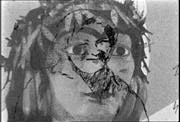
email: kunst@earthlink.net
digital film and video artist
"The idea of cinema is constant and timeless while the notion of medium ages within a liquid array. Cinema becomes the thread passing on its ghosts and providing a soul for the new digitial mediums."
My work began with 16mm film. It migrated to video and transformed itself into a composite of architecture and digital image installation. Currently I found a home within an interactive cinema based on dreams and memory.
With this progression of mediums, the one constant throughout is a cinematic one. What I have tried to do is to liberate the process of cinema from the film medium and transport it to the electronic and digital environments.
"The particular metaphor on vision is the "view", a word suggestive of both the passive (noun) and active (verb), and ambigious in its tension between sight and idea. Indeed, while subtly modulating a few recurrent images-and image sources-Leeser reworks and expands polarities that foucus on public versus private seeing, the culturally over-determined and personally hermetic, the interior/denatured image and the exterior/found rerecorded image. His films are rich in analytical potential but steer wide of the drearily didactic work of some English filmmakers who chart a similar terrain. -Paul Arthur, "Coming into View"

I began making films in the 1970's. After going to the San Francisco Art Institute, I moved to Los Angeles and worked with the now defunct Los Angeles Independent Film Oasis. During this time my films grew from the materialist concerns of "View", to a more fractured critique of perception that bordered on recreating the dream state, in "Opposing Views and "Gratuitous Facts".
"A spirit of cutting, tearing and digging also pervades "Madame Mao's Lost Love Letters", a series of five, thirty second videos by Tom Leeser and Dianne Wilson. Wilson provides two overdubbed tracks of each of the segments. Her texts include poetry, political catch words, lists of disease symptoms, archaeological reports and astronomy statistics for which Leeser compiles and composes imagery.
Together, with a media archaeologists' enthusiasm, they alternately bury and exhume layer upon layer of material. Words and images scratch and undulate their ways through each other, resulting in dense core samples of a late twentieth century information base." -Larry List, curator "Found Language" Franklin Furnace
In 1983, I moved back to New York City and began mixing the mediums of film and video, producing "Madame Mao's Lost Love Letters". This work began on 35mm film using animation and optical printing techniques. It was eventually transferred to video and shown in that format.
The work is a collaboration with writer and anthropologist Dianne Wilson. The found language collages are combined with imagery to produce an assault of the senses, further investigating the possibilites of fractured narrative structures within the dream state.
It was around 1984 that I began my involvement with computer graphics. Working on an early manifestation of a "paint box" my work moved to a digital still medium.
Exhibited as photographic output from the computer, the themes were a continuation of "Madame Mao' Lost Love Letters".
Serial in nature, they combined found language with imagery taken from broadcast and print sources.
This led to a series of installations produced with artist Alison Saar. The collaboration known as the "Kunst Brothers", mostly took an ironic stance towards western culture using architectual reference, film and video.

"In a gesture of ironic humor, the Kunst Brothers in "Volta Votive" have constructed a building of old car batteries for its exhibition which adjoins Battery Park. They filled the structure with sand scattered with artifacts of the cultural and historic past, just as the land beneath The World Financial Center was created from an immense landfill project in what was once the Hudson River. Set in a dramatically darkened space, the structure further refers to historical antecedents by taking its circular form from a portion of Castle Clinton, which guarded New York Harbor from the time of early Dutch settlements; it is also intended to refer to ceremonial sites of earlier Native Americans. The negatives and positives of development as well as electrical current are suggested- and the visual pun extended-by the use of plus and minus signs for door and window. -Philip Yenawine Director of Education, Museum of Modern Art, New York
In 1988, "Volta Votive" was presented at the "New Urban Landscape" show at Battery Park in New York City.
Since 1990 I have been collaborating with muscians. Using the music in ways that I used language from the earlier work, I have produced a series of "blind trusts".



"The music by Zeena Parkins and images were created separately, with a total trust between artist and composer- what is interesting is exactly this unplanned association. The video offers a visual landscape, a poetical nature of a narrative inside memories and dreams." -Videobrasil: Festival Internacional de Arte Eletronica 1994
This collaboration was made with composer Butch Morris.

This installation was produced for Siggraph, 1994 in Orlando, Florida. My first interactive work, it was designed to be a virtual space.
The space (a 8'X6'X4' black box) insulates the viewer from all exterior distractions. The room is similar in design to a photo booth or a church confessional. Inside, there are two video monitors: one nine-inch black and white and one twelve inch color, mounted side by side.
The black and white monitor displays dreamers recounting their visons. The color monitor plays back video collages that are constructed to combine random collections of images and text.
Unlike typical interactive programs that include viewer choices and branching
capability, this system works on randomness. The computer randomizes the
playback of the video each time a viewer enters the space.
also: Kunst Brother Web Site
